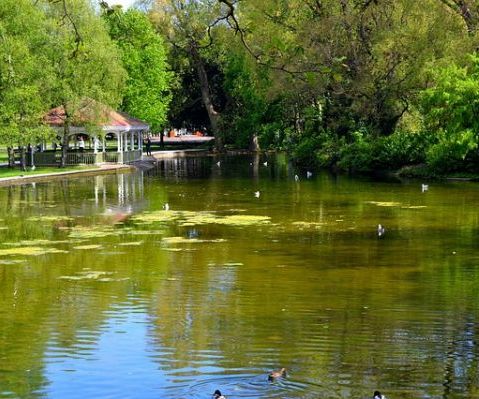How do blue-green algae form?
Blue-green algae grow best when there are high levels of nutrients in the water, such as phosphorus and nitrogen.2 These nutrients can get into the water by run-off of:
- Fertilizers
- Farming materials
- Industrial wastes
- Waste management systems, and
- Faulty septic systems.
Back to top
Should I be concerned about blue-green algae?
Although many varieties of blue-green algae are harmless, some can produce toxins that are harmful to the health of both humans and animals.2 People can become ill from contact with blue-green algae toxins, therefore take a cautious approach with blue-green algal blooms. View information about blue-green algae (PDF 3.6MB) to learn about the potential health effects associated with blue-green algal toxins.
Back to top
How might I come in contact with blue-green algae toxins?
Possible ways you can come into contact with blue-green algae toxins in water are:
- Direct contact of water with your skin 3
- Swallowing / drinking water 3
- Breathing in water droplets or mists in the air,3 or
- Eating fish from a water body where blue-green algal blooms occurred.2
Back to top
How can I reduce coming into contact with blue-green algae toxins?
The list below suggests ways to help reduce contact with blue-green algae toxins in areas where blue-green algae is found:2
- Do not drink, bathe or shower in untreated water - avoid using the water.
- Do not allow people, pets or livestock to drink or swim in the water.
- Do not eat the liver, kidneys or other organs of fish caught in the water. Be cautious about eating fish caught in water where blue-green algae blooms occur.
- Do not use herbicides, copper sulphate or other algaecides that may break open algae cells and release toxins into the water.
- Do not boil the water or manually treat the water with chlorine or other disinfectants, as this could increase the toxin levels.
- Do not rely on home treatment systems to remove toxins as they can get easily overwhelmed or clogged.
- Use alternate water sources, such as bottled water, or call a water treatment service provider for help.
Back to top
Can my drinking water be contaminated with toxins from blue-green algae?
If drinking water is obtained from a water source that is not properly treated during a blue-green algal bloom, then it is possible that the water may be contaminated with toxins.4 Usually people won’t drink water contaminated with blue-green algal blooms because of its unsightly pea soup appearance and foul smell.4 However, drinking water obtained during an algal bloom should be tested for algal toxins because sometimes it’s hard to tell from its appearance whether the drinking water has been contaminated.4
Back to top
How much cyanobacterial toxin is allowable in Ontario drinking water?
The Ontario Drinking Water Quality Standards state that the current allowable level of microcystin-LR (a cyanobacterial toxin) is a concentration of 0.0015mg/L or 1.5 parts per billion.2
Back to top
Can water containing blue-green algae / cyanobacteria be treated to make it safe to drink?
Drinking Water System Operators will monitor drinking water quality more frequently once a bloom is reported in the area of the water intake.2 Central treatment plants usually have filtration, chlorination, and other treatment systems that are capable of removing the algal cells and toxins.2 For more information on how water systems can be treated, view Ontario's Blue-Green Algae: Information for drinking water system owners and operators (PDF 2.7MB) fact sheet.
Back to top
Additional Information
For more information on blue-green algae, visit Ontario's Blue-green algae web page.
To speak to a Public Health Inspector on the Environmental Health Team about blue-green algae, please call:
